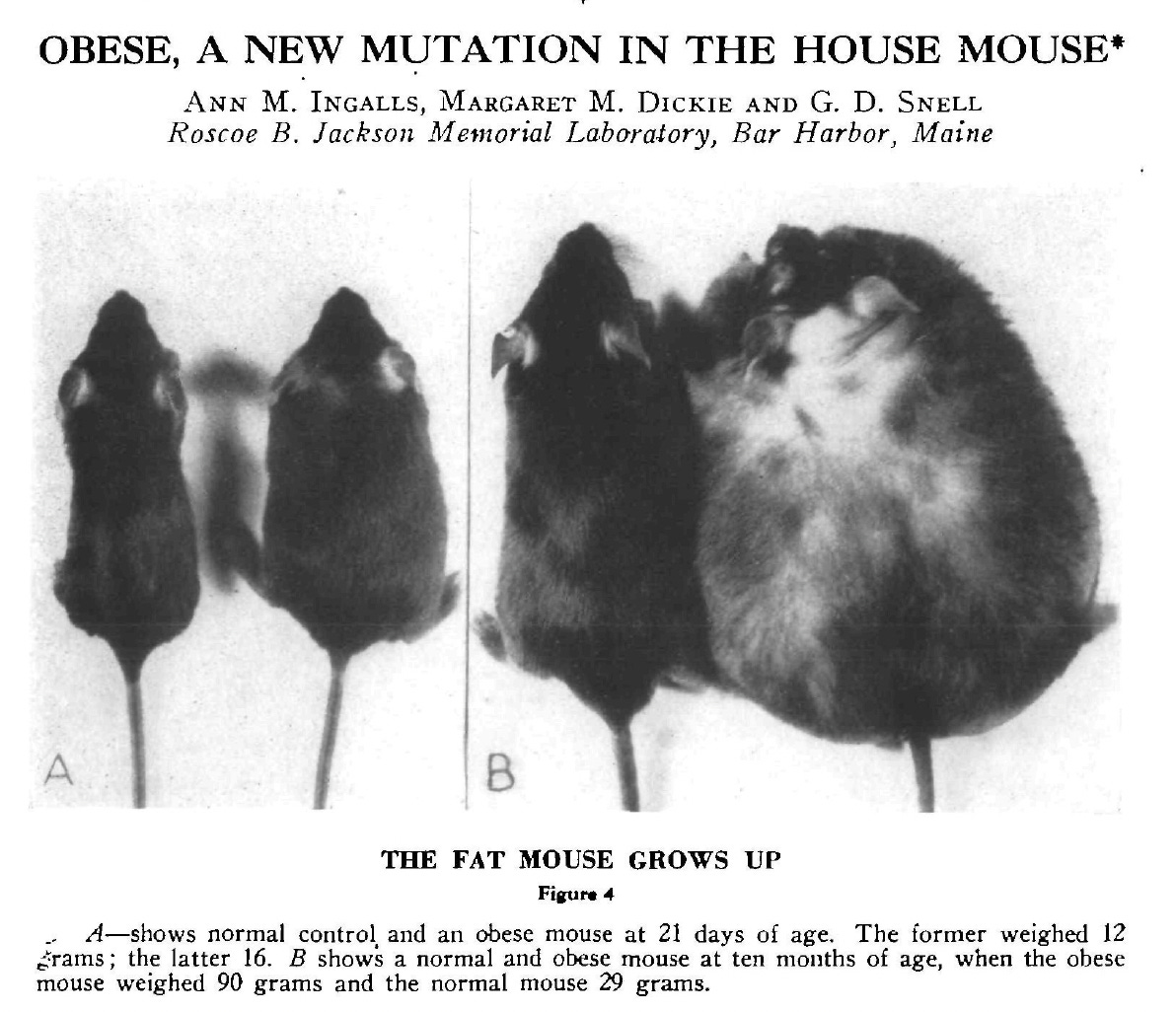Lessons From the Original (Very) Fat Mouse
Is it possible that obesity science went hopelessly off the rails 30 years ago because of one obese mouse and one researcher who didn’t do his homework? Short answer: yes.
The prevailing interpretation of the ob/ob mouse—that it eats too much because it lacks a satiety signal—has dominated obesity science for 30 years. But what if that interpretation was mistaken from the start? What if the ob/ob mouse becomes obese not because it overeats, but because it shunts calories into fat regardless of how much it eats?
This is one of those posts in which we’re going to pretend that we’re scientists and work through a thought experiment. The subject of our experiment will be a mouse known as the ob/ob mouse, with ob, unsurprisingly, short for obese. The ob/ob mouse is not the fattest of the mouse models of obesity, but it is, per the image below from the 1950 paper reporting on its discovery, a profoundly fat rodent.
In 1994, a team of researchers at Rockefeller University led by Jeffrey Friedman announced that they had discovered and cloned the gene responsible for the obesity in the ob mouse. Friedman named it leptin, for the Greek word leptos, meaning thin, and its discovery launched the modern era of obesity research.
I’m not exaggerating when I say that Leptin catalyzed the transformation of obesity research into what the medical community could consider a serious science, essentially a subdiscipline of molecular biology and genetics. In the process, it led to what Friedman described recently in Cell Metabolism, as “an explosion of information about the neural circuits that regulate appetite,” and to the revelation “that obesity is a brain disorder,” a disorder, specifically, of what the insiders in this science call appetitive behavior. It’s because of Friedman’s conception of leptin that lay books about obesity science have titles like The Hungry Gene (Ellen Ruppel Shell, 2001) or The Hungry Brain (Stephan Guyanet, 2017).
But what if Friedman got it wrong? That’s the question we’re going to be asking in our thought experiment: What if the basic premise that guided Friedman’s interpretation of leptin and its actions, and so this entire scientific revolution, was wrong from the start? What if Friedman didn’t do his homework?
Because if Friedman did get it wrong, then that “explosion of information about the neural circuits that regulate appetite” can assumed to be mostly misguided as well. (Friedman would damn this premise as hubris. I know that, because he told me so. But sometimes a little hubris is unavoidable in science. The goal, after all, is not to avoid hubris, self-destructive as it may be, but only to establish reliable knowledge.)
The thought experiment
So back to our mouse: Here’s Ellen Shell in the The Hungry Gene, describing the discovery of the ob/ob mouse at the Jackson National Laboratory in Bar Harbor Maine 75 years ago:
An animal caretaker first spotted the creature huddled in a corner of its cage, grooming itself. It was furrier than most, but what really stood out was the size of the thing—it was hugely fat. The caretaker alerted doctoral candidate Margaret Dickie, who diagnosed the mouse as “pregnant.” But there were problems with this theory. For one thing, the mouse never delivered a baby. And on closer inspection, it turned out to be male. The fat mouse ate three times the chow eaten by a normal mouse, pawing for hours at the bar of the food dispenser like an embittered gambler banging away at a recalcitrant slot machine. Between feedings it sat inert. It seemed to have been placed on this earth for no other purpose than to grow fat….
This mouse was outlandish, a joke, a blob of fur splayed out on four dainty paws like a blimp on tricycle wheels. Rather than dart around the cage in mousy abandon, it was docile, phlegmatic, as though resigned to some unspeakable fate.
As the Jackson Lab breeders would learn when they tried to propagate the mutant mouse, the ob gene is a recessive gene. That means an animal (or human) needs two copies of the defective gene to manifest what geneticists would call the obese phenotype. This is why the obese mouse is now known as ob/ob. With only one copy, the mice remain lean.
Now in our thought experiment, we’re going to do what Friedman and his colleagues did and clone the gene for the ob/ob mouse and interpret what it does. When Friedman et al took on this challenge in the mid-1980s, molecular biology was in its adolescence. Their effort was heroic (or maybe monomaniacal, depending on how you see heroism these days), and took the better part of a decade.1
Keep reading with a 7-day free trial
Subscribe to Uncertainty Principles to keep reading this post and get 7 days of free access to the full post archives.


